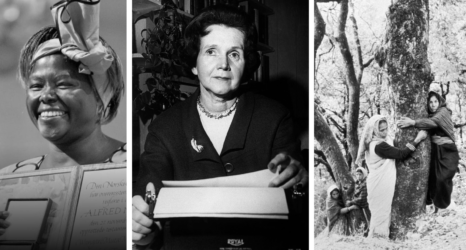Amnesty International’s recently-released Here I Stand: Stories that Speak for Freedom is a collection of works by preeminent contemporary artists and writers that explore human rights issues in the modern world. Intended for teenage and young adult readers, this “fiction for empathy” doesn’t shy away from contending with some of the darkest aspects of the human condition in the twenty-first century. The abused and abandoned find their rightful place in its pages, which return story after story to one fundamental problem: the importance of caring for others’ suffering instead of turning our eyes away.
Many of the stories in Here I Stand trace their roots to injustice. Jackie Kay, Scotland’s National Poet, contributed three poems based on her interviews with refugees. Other pieces have origins further back—in the comic “Deeds Not Words,” Mary and Bryan Talbot and Kate Charlesworth explore the life of Lady Constance Lytton and the struggles of the suffragettes at the opening of the twentieth century. The book concludes with an interview with Chelsea Manning, only the latest stage of Amnesty International’s campaign to bring recognition and ultimately release to her and other prisoners of conscience.
Even the entirely fictional stories in the anthology are based on truth. Novelist Bali Rai’s story was inspired by the real life story of Anthony Walker, a British teenager who was killed in a 2005 racial hate crime. After speaking to a man sentenced to death in San Quentin State Prison, Ryan Gattis wrote his story “Redemption” about both the impracticality and the inhumanity of capital punishment. Another contributor, Frances Hardinge, was spurred to write her story “Bystander” after learning of the all-too-recent torture of Kevani Kanda, who at the age of six was branded a witch and abused by her own family.
Hardinge, who has published 11 short stories and seven novels—the most recent of which, The Lie Tree, won the Costa Book of the Year Award and was short-listed for this year’s Carnegie Medal—spoke with Ms. about “Bystander” and feminism in her work.
You’ve said that “Bystander” is inspired by the real story of Kevani Kanda. Could you tell us anything about that case—how you heard about it, or how you decided to write about it for Here I Stand?
I originally agreed to write a story about torture, and had some idea of writing about the seventeenth century witch trials. When I mentioned this to Amnesty, however, they remarked on the fact that there were children in the modern day UK who were being accused of witchcraft by their families and communities, and subjected to various forms of torture to ‘exorcise’ them. Not all of them survived this.
I hadn’t known about this, and now that I did it seemed wrong to focus on the old witchcraft torture cases and ignore the fact that such things were still happening. Ronke Phillips, an award-winning journalist, kindly gave me help and information on such cases. I was haunted by the story of Kevani Kanda, whose relations subjected her to horrific abuse for four years, beginning when she was six years old. At the time she regarded all of this as ‘normal’, and believed the adults who told her that she was a witch. Sometimes she resorted to stealing packed lunches from other children at school, because she hadn’t been fed.
Kevani Kanda has grown up to be a remarkable woman. She now campaigns to raise awareness of such abuse so that other children do not have to suffer. She has generously allowed me to use elements of her ordeal in my story.
Each story in Here I Stand is followed by a message to its readers from the author or illustrator, but you’re one of the few authors in the anthology to end with direct and practical advice for any reader placed in a situation like that of your main character. If fiction is a form of activism, then, do you view its end goal to be more than just raising awareness?
I don’t usually tell my readers what to do, any more than I generally tell them what to think. I generally prefer exploring issues and ideas rather than rolling out a manifesto. My views come out in my work, of course, but hopefully in a reasonably complex way.
This story was something of a special case. It’s not just a story about torture, it’s also a tale about silence, fear and complicity—the elements that can prevent essentially good people from stepping up to the plate to stop terrible things happening. The end note was needed in order to make it clear that the final decision made by the main character was not inevitable or unavoidable. There were positive things that could have been done, and it seemed important to state what these were.
Faith, the main character of your most recent novel The Lie Tree, lives in a male-dominated Victorian society that tells her continually that women are not intelligent or capable—she has to figure out the truth for herself. In fact, it seems like almost every one of your books has at its heart a young female protagonist still in the process of coming to an understanding of the world around her. Why are these the kind of stories that you choose to tell?
Not all of my protagonists are female (one is male) but it’s certainly true that all of them are smart young people who are learning to question the ways they have been taught to perceive the world, and finding a new understanding of themselves in the process. I am fascinated by this life stage, which can be simultaneously painful, disillusioning, world-expanding and empowering.
I also think that there’s something to be said for channelling this questioning attitude later in life, so that we don’t ossify into comfortable attitudes and habits of thought.
Your heroines are often reflexive and intuitive resisters contending with a more conservative world of adults, women as well as men. Faith’s mother especially seems initially unpleasant, but we discover that she’s really just trying to pass on survival skills to her daughter—when she starts being honest about that, they can work together so much more. How much do you consider female solidarity in your novels, or do you see women as sometimes part of the problem, previous generations perpetuating needless survival skills rather than pointing out that it’s time to rebel?
I’m always interested in different types of solidarity and division, whether all-female or otherwise. (In The Lie Tree the Victorian treatment of women is integral to the plot, but my books actually touch on other sorts of inequality, prejudice, friction and miscommunication as well.)
In the case of The Lie Tree, I’ve actually got quite a lot of sympathy with Myrtle. She can be dreadful and manipulative, but she’s trying to make her way in a world where the odds are stacked against her. The survival skills she has developed and wants to pass on aren’t really needless. Survival is quite a necessary thing!
Myrtle believes that Faith will face social, practical and financial difficulties all her life if she defies convention. She’s right. She believes that Howard with face stigma and trouble if he can’t write with his right hand. She’s right about that too. I certainly can’t blame her for wanting to spare her children a harsh and difficult future.
One of the things that I wanted to make clear in The Lie Tree is that rebellion is hard. It takes huge amounts of energy, doggedness and self-belief, and it has consequences. Even overcoming one’s social programming to the point where one can decide to rebel takes a significant psychological leap. All of us, male and female, internalise what we are told and taught, so that the views we hear expressed every day become ‘self-evident’, part of our bone marrow. When Dr. Jacklers the craniometrist comments on the inferiority of the female intellect, he’s not being deliberately unfair. He’s speaking in good faith on a matter he considers uncontroversial, and would be horrified if anybody accused him of helping to oppress women.
So while I deeply admire those women who did defy convention, I also have plenty of sympathy for those who subverted the system instead, or didn’t rebel because of the impact it would have on their lives and families, or who believed in society’s codes and soldiered on within them as best they could. (It’s also worth mentioning that rebellion would have been considerably more difficult for those women further down the social scale.)
Faith has a rocky path ahead, and has chosen it with her eyes open. However, removing some of those rocks will be a lot easier with the pragmatic Myrtle on side…
So many of your characters come to “Here I Stand” moments in dire situations. Do you feel that the whole project thus fits with your work as a novelist and a feminist, and your determination to make those professions reinforce each other rather than compromise each other?
In the case of my story for Here I Stand I was given a theme to write about (i.e. torture) and then came up with the storyline for “Bystander.” This isn’t usually the way I work. First and foremost, I’m a storyteller. As previously mentioned, when I’m writing a novel, I don’t come up with a manifesto and then wrap a story around it! However I do have certain bees in my bonnet, and when I write they come out for a little buzz.
There are issues that concern and fascinate me. Ours is an ingenious, wonderful, unpredictable and courageous species, but fear still brings out the worst in us, and throughout history we have shown a regrettable tendency to demonise each other or treat one other as inferior. In my books I don’t just set out to decry this tendency, I try to unpick it and understand it. My feminism is an inevitable part of my hope that humanity can overcome this habit and reach a state of true equality.
It’s true that my protagonists often find themselves facing situations which are a test of their character – a moment when they can either muster their courage or take the easy route. In my head, I tend to think of characters who pass this test as ‘making the jump’. It’s a heroic achievement, overcoming one’s own fears, programming, lifelong habits, sense of personal limits or desire for approval.
In “Bystander” the protagonist fails to ‘make the jump,’ for what are hopefully comprehensible reasons. However, most of my main characters do eventually choose to make a stand or follow their consciences. I guess at heart I’m an optimist. I believe that we can all make the jump.





